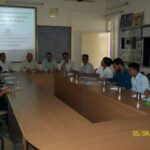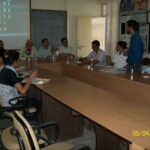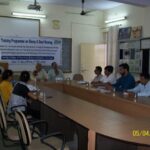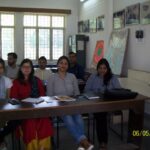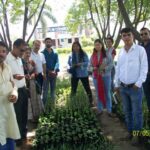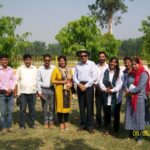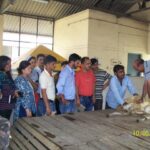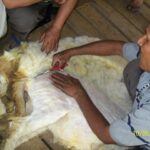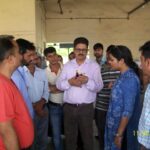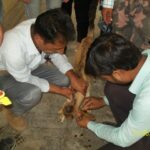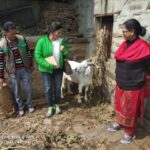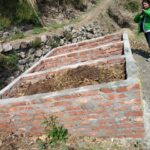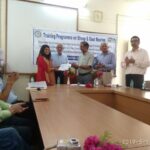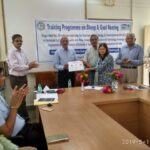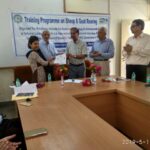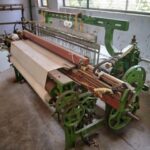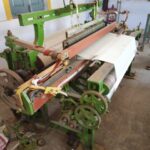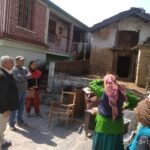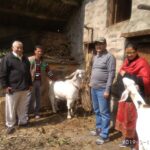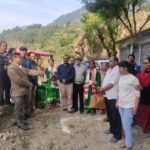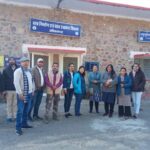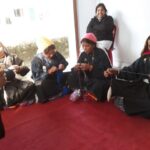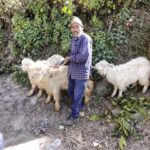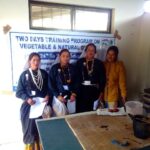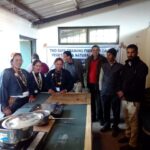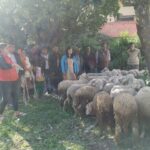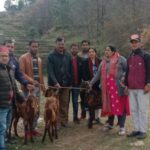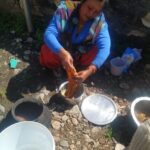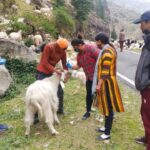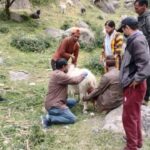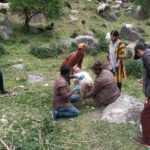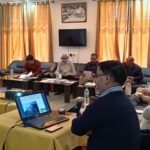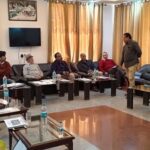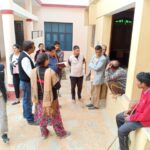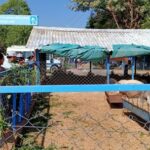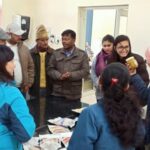STRENGTHEN LIVELIHOOD OPPORTUNITIES OF SMALL RUMINANT REARERS
STRENGTHEN LIVELIHOOD OPPORTUNITIES OF SMALL RUMINANT REARERS IN ECO-FRAZILE MOUNTAINOUS TRIBAL REGIONS OF UTTARAKHAND THROUGH ORGANIZATIONAL NETWORKING SYSTEM FOR PRODUCT DEVELOPMENT & DIVERSIFICATION AND MARKETING
INTRODUCTION AND BACKGROUND OF THE PROJECT
The rugged terrains of Uttarakhand and Himachal Pradesh cradle a mosaic of tribal and marginalized communities, each bearing a unique cultural tapestry. Among these distinct groups are the Bhotia, Jaunsari, Raji, Tharu, Buksa, Kinnaura, Lahaule, Gaddi, and Gujjar, each characterized by well-defined territories, nomenclature, languages, intricate kinship structures, clan affiliations, and deeply-rooted religious beliefs. These communities, while bound by economic challenges and shared cultures, are steadfast in their commitment to preserving their identity and maintaining a self-sustaining way of life. Officially recognized as Scheduled Tribes, or referred to by various local designations like “Anusuchit Jati,” “Vanjati,” “Vanbasi,” “Pahari,” and “Adimjati,” these groups inhabit specific tribal pockets, shaped by their historical affiliations and unique tribal identities. For instance, Tharu and Buksa communities thrive in the Tarai-Bhabar region, while the lofty heights of several districts provide a home to the Bhotia tribe. The Raji people predominantly inhabit the Kanalichhina and Champawat blocks, and the Jaunsari tribe finds its roots in the Chakrata and Kalsi blocks of Dehradun district. Intriguingly, amidst this rich diversity, there exist shared threads of economic and social life that serve as unifying bonds, albeit with nuanced adaptations to harmonize with local resources. Agriculture stands as the backbone of subsistence for tribes like Tharu, Buksa, and Jaunsari, grounding their communities in a life deeply intertwined with the rhythms of the land. For the Bhotia tribes, animal husbandry reigns supreme, with a particular focus on livestock such as milk-bearing cattle, meat-producing animals, and wool-yielding creatures, all vital for their livelihoods. Moreover, the Bhotia tribe sustains a thriving woollen handicraft industry, their nimble hands crafting intricate textiles. The forest, with its bounteous offerings, plays a pivotal role in the survival strategies of these communities, offering sustenance and livelihood opportunities.
Nonetheless, the path is far from easy for these resilient communities. They grapple with a multitude of challenges, from small and fragmented landholdings to limited income prospects and scarce employment opportunities. Inadequate road networks and exorbitant transportation costs stymie economic growth, while healthcare services remain distressingly inadequate. Access to clean drinking water and irrigation facilities is a constant struggle. Moreover, while traditional skills like spinning, weaving, and wool processing remain ingrained in their heritage, the lack of modern design inputs and raw materials, coupled with the formidable obstacle of high transportation costs, pose formidable barriers to their economic well-being. As a result, their earnings often fall short of sustaining them throughout the year, leading to the widespread migration of youth from the hills to urban plains in search of economic opportunities. Within this intricate tapestry, the communities also engage in goat and sheep rearing activities, further contributing to their livelihood strategies. It is within this dynamic landscape that the resilient tribal beneficiaries navigate their lives, with hopes of overcoming these challenges and forging a brighter future for themselves and the generations to come.
AIMS AND OBJECTIVES OF THE PROJECT
1. Conduct comprehensive surveys and documentation, including Indigenous Traditional Knowledge (ITK), to capture existing sheep and goat rearing practices, product processing methods, market connections, and assess the viability of enhanced farming techniques within local communities.
2. Deliver targeted training sessions to project partners, equipping them with the skills to identify genetically superior male breeds of sheep and goats in specific areas, thereby augmenting qualitative and quantitative outputs such as body weight, wool, and skin.
3. Provide in-depth training to marginal farmers on all aspects of sheep and goat rearing, encompassing breeding, feeding, disease management, pasture development, and post-harvest product processing. Emphasis will be placed on integrating renewable energy-powered equipment (solar) for value addition. The establishment of robust market linkages will also be prioritized.
4. Elevate the livelihoods of marginal farmers by introducing advanced technology for wool processing and optimizing the rearing of lambs and kids to reach the ideal age for marketing.
5. Facilitate meaningful interactions between transhumant and stationary animal breeders and pertinent departments including forest, animal husbandry, MSME, agriculture, organic board, KVK, finance, and market support institutions. Rigorous assessments will be conducted to gauge the effects on their livelihoods and social security.
COMPONENTS AND ACTIVITIES OF THE PROJECT
1. Carefully select appropriate Project Partners, target areas, and beneficiaries for the strategic implementation of the sheep and goat rearing ecological livelihood program.
2. Adhere to the established guidelines of the Government of Uttarakhand while identifying beneficiaries, ensuring the avoidance of overlapping benefits from various welfare schemes and optimizing project efficiency.
3. Establish Self Help Groups (SHGs) and foster their cooperative federation to facilitate streamlined and effective program implementation.
4. Source high-quality germplasm and breeds of sheep and goats, leveraging expert guidance from diverse locations across varying altitudes and terrains, taking into consideration specific migration cycles.
5. Follow the Government of Uttarakhand’s guidelines transparently for the procurement of animals, ensuring compliance with the prescribed protocols.
6. Distribute improved germplasm and breeds to beneficiaries in alignment with the Government’s breeding policy and availability from different authorized Government sources.
7. Conduct rigorous scientific analysis of initial field data to evaluate the genetic and nutritional potential of sheep and goats, considering diverse feed and fodder options available.
8. Establish comprehensive veterinary facilities to effectively manage disease control and enhance production yields encompassing milk, body weight, wool, fur, and fiber, taking into account the distinct altitudes and terrain conditions.
9. Develop a state-of-the-art Common Facility Centre (CFC) equipped with advanced solar-powered equipment, including an amber charkha for wool processing, to augment the value addition chain.
10. Promote the adoption of organic crop cultivation techniques using locally suitable crops with high nutritional value. Implement advanced methods such as vermi composting and Bio-fertilizer technology for sustainable agriculture practices.
11. Harness the potential of manure and waste through vermi composting and Bio-fertilizer technology to support organic crop cultivation and enhance soil fertility.
12. Perform a comprehensive impact assessment upon the culmination of the project to ascertain its overall success and outcomes, ensuring a robust evaluation of its achievements and benefits.
TARGET AREA OF THE PROJECT
The project strategically aims to focus on distinct geographical regions within Uttarakhand, with a specific emphasis on tribal areas in Dehradun, Uttarkashi, Chamoli, and Pithoragarh districts. These districts have been carefully selected due to their potential for the successful implementation of a sheep and goat rearing program.
TARGET GROUPS AND BENEFICIARIES OF THE PROJECT
The project’s primary beneficiaries are the Scheduled Tribe (ST) families residing in the designated regions of Dehradun, Uttarkashi, Chamoli, and Pithoragarh districts in Uttarakhand.
FUNDING PARTNER OF THE PROJECT
The funding for the project is being provided by the Department of Science & Technology (DST), Ministry of Science & Technology, Government of India, New Delhi.
SANCTIONED BUDGET OF THE PROJECT
The project was granted approval by the DST in 2018, under the sanction order No. F. No. SP/TSP/029/2016 (G) dated 31.12.2018. The sanctioned budget for the project was Rs. 3,33,09,000.00, allocated for a duration of three years.
OUTCOMES AND ACHIEVEMENTS OF THE PROJECT
The successful implementation of the small ruminant project has resulted in the following outcomes and achievements:
1. The baseline survey has been conducted to document and compile information related to existing sheep and goat rearing practices, product processing, market linkages, and assessment of improved practices on farming communities. Indigenous Technical Knowledge (ITKs) has been documented to ensure that traditional knowledge is preserved.
2. Project partners have been trained to select genetically superior breed males of sheep and goat in particular areas to improve the qualitative and quantitative production of body weight, wool, and skin sectors.
3. Marginal farmers have been trained on sheep and goat rearing, including breeding, feeding, disease control and management, pasture development, post-harvest product processing, value additions in a scientific manner, and the usage of renewable energy-powered equipment (solar). This has provided market linkage and increased the income of these farmers.
4. High-quality germplasm/breed of sheep and goat has been arranged by seeking guidance from experts in different locations at varying altitudes and terrain. Animal purchase has been done transparently as per the guidelines set by the Government of Uttarakhand.
5. Improved quality of germplasm/breed has been provided to beneficiaries from various government sources as per the government breeding policy. Scientific analysis of the preliminary field data has been done to evaluate the genetic potential of sheep and goat and nutritional potential of various feed and fodders.
6. Veterinary facilities have been provided for disease control and improvement in yield of milk, body weight, wool, fur, and fiber at different altitudes and terrain conditions.
7. A Common Facility Centre (CFC) has been set up by installing advance equipment like handlooms, amber charkha, etc. operated by solar energy sources for wool processing for value addition chain.
8. The livelihood of marginal farmers has been enriched by adopting advanced technology in processing wool and rearing of lamb and kids up to the optimum age of marketing. This has enabled farmers to get a better price for their products in the market.
9. Transhumant and stationary animal breeders have been facilitated with line departments such as forest, animal husbandry, MSME, agriculture, organic board, KVK, finance, and market support institutions. This has assessed the impact on their livelihood and social security, ensuring that these farmers are able to sustain their livelihoods and continue their traditional practices.
10. Awareness and encouragement of organic crop cultivation of local crop/commodities having high nutritional value with advanced techniques of vermi compost and Bio-fertilizer technology have been provided. Manure and wastage have been utilized for organic crop cultivation through vermi compost and Bio-fertilizer technology.


